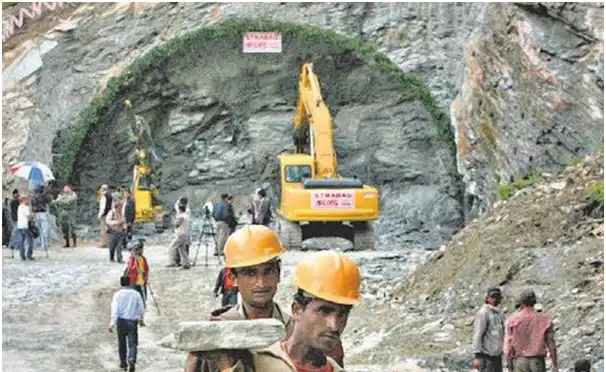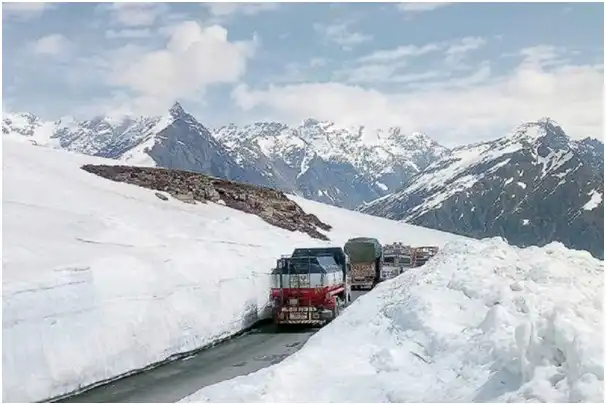The Atal Rohtang Tunnel is a remarkable infrastructure project that will connect the Lahaul-Spiti valley to the tourist town of Manali in the northern state of Himachal Pradesh, India. The tunnel will also form part of an all-weather access route to the mountainous regions of Leh and Ladakh in Jammu and Kashmir Atal Tunnel, Rohtang is named after former Indian Prime Minister Atal Bihari Vajpayee, is a highway tunnel built under the Rohtang Pass in the eastern Pir Panjal range of the Himalayas on the Leh-Manali Highway.
The tunnel was planned for ensuring an all-weather road route to strategically important areas of Ladakh and providing round-the-year connectivity to the remote Lahaul-Spiti valley. However, the construction of Rohtang tunnel will provide all-weather connectivity only to the Lahaul Valley of Himachal Pradesh up to Kyelang (Keylong). The all-weather road to Ladakh will require more tunnels: either at Shikunla, or at the passes located on the present Leh-Manali road for a year-round road connectivity to Ladakh.
The project was conceived in 1983 and announced by prime minister Atal Bihari Vajpayee on 3 June 2000. However, the project did not take off. The project was estimated to cost ₹5 billion in 2000 to be completed in seven years. On 6 May 2002, the Border Roads Organization was entrusted with the construction of the tunnel.
However, still the work did not progress much and the project did not move beyond the tree-felling stage by May 2003. By December 2004, the project cost estimate had escalated to ₹17 billion. In May 2007, the contract was awarded to SMEC (Snowy Mountains Engineering Corporation) International Private Limited, an Australian company, and the completion date was revised to 2014. Despite multiple announcements that the work on the tunnel would begin in 2008, no progress had been made by November 2009.
The work was awarded to a joint venture of AFCONS Infrastructure Limited, an Indian construction company of Shapoorji Pallonji Group, and STRABAG AG, Austria in September 2009 after the Cabinet Committee on Security cleared the Rohtang Tunnel Project.
Challenges faced for execution of The Atal Rohtang Tunnel
The most challenging task was to continue the excavation during heavy snowfall in winter. Excavation for tunnelling was done from both ends. However, as Rohtang pass closes during the winter, the north portal was not accessible during winter and the excavation was being done only from the south portal in winters. Only about one-fourth of the entire tunnel was excavated from the north end and three-fourths was excavated from the south end. There were more than 46 avalanche sites on approaches to the tunnel.

Other challenges to the progress of the tunnel included difficulties in disposing more than 800,000 m³ of excavated rock and soil,heavy ingress of water (as much as 3 million litres per day in June 2012) that required constant dewatering, costlier treatment and slowed the progress of excavation from 5-metre per day to just half a metre a day and unstable rocks that slowed blasting and digging. A cloud-burst and flash flood on 8 August 2003 killed 42 labourers who were building the temporary access road.
Standout features of The Atal Rohtang Tunnel
- At 9.02 km (5.6 mi) length, the tunnel will be one of the longest road tunnels in India and is expected to reduce the distance between Manali and Leh by 46 km (28.6 mi).
- The tunnel is at an elevation of 3,100 metres (10,171 ft) whereas the Rohtang Pass is at an elevation of 3,978 metres (13,051 ft).
- The tunnel will keep the highway open during the winter.
- Atal Tunnel, the horseshoe shaped single-tube, double-lane tunnel has many firsts
- It is also the country’s first tunnel to have an escape tunnel within the main tunnel because of the topography
- This is also the first tunnel to deploy the Rowa flyer technology, which allows engineers to work at inverted levels
- Atal Tunnel in Lahaul Spiti’s Rohtang will shorten the distance between Manali and Leh by 46 kms and drive time by around seven hours
- The tunnel will provide all-weather connectivity to remote border areas of Himachal Pradesh and Ladakh which otherwise remain cut-off from the rest of the country for about six months during winters
- The tunnel has consumed 14,508 metric tonnes of steel and 2,37,596 metric tonnes of cement, and excavated out 14 lakh cubic metres soil and rocks, using the drill and blast technique for excavation
- The New Austrian Tunnelling method for construction adopted for the tunnel

Construction method adopted for the Atal Rohtang Tunnel
The principal support system for the tunnel will be a combination of fibre reinforced concrete and rock bolt. Yieldable steel ribs will be used as additional support in poor rock areas.
The tunnel will have semi-transverse ventilation with fans to circulate air. The long distance of the tunnel and the high altitude have necessitated the special ventilation system.
Construction of one of the two access roads was completed in 2005. The road connecting the south portal of the tunnel to Manali is 2.7km long. It will have 18 avalanche protection structures. The 23.8km north portal road will connect the tunnel to Manali-Sarchu road. The two roads are estimated to cost Rs1.8bn ($38m). The approach roads will initially help in carrying the construction material to the site. They will be later developed to meet the specifications of a National Highway double lane.
It is 8,802-metres long and about 3,000 metres above sea level. The single tube bi-lane tunnel, 5.5 metres high, was bored through solid rock nearly two kilometres under the Rohtang Pass. The makers used a drill and blast technique for excavation, coupled with the New Austrian Tunnelling Method for construction.
Another parallel tunnel of 3.3×2.2 metres, an emergency passage of sorts, has been constructed under the Atal Rohtang tunnel with staircases at every 500 metres connecting it to the main tunnel. Three thousand cars and 1,500 trucks can pass through the Atal Tunnel at 80 km per hour.
Contractors for Atal Rohtang Tunnel
- The construction contract of the tunnel has been awarded to Strabag-Afcons, a joint venture between India-based Afcons Infrastructure and Austria’s Strabag.
- The contractors were selected after the project was approved by the Indian Cabinet Committee on Security in September 2009.
- Australia-based SMEC (Snowy Mountains Engineering Corporation) will provide design and project management services until completion of the project.
- The feasibility study for the project was done by Rail India Technical & Economic Services (RITES).
Conclusion
The project is even more significant due to the rising tensions on the eastern front with China. Since May this year, the procession of Army trucks through the Rohtang Pass has been almost ceaseless, as men and material are ferried to the flash points in Ladakh. Not only does the tunnel mean quicker supplies, but also that Army convoys are no longer hostage to the vagaries of nature and snowfall. The opening of the tunnel is scheduled by the 3rd of october.
Info and image- livemint, road traffic technology, business standard, india today, times now, hindu, outlook india, deccan herald

